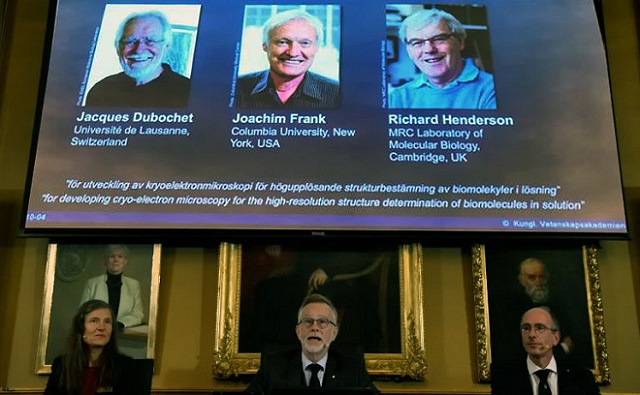
Stockholm, Sweden | AFP | A revolutionary technique dubbed cryo-electron microscopy, which has shed light on the Zika virus and an Alzheimer’s enzyme, earned scientists Jacques Dubochet, Joachim Frank and Richard Henderson the Nobel Chemistry Prize on Wednesday.
Thanks to the international team’s “cool method”, which uses electron beams to examine the tiniest structures of cells, “researchers can now freeze biomolecules mid-movement and visualise processes they have never previously seen,” the Nobel chemistry committee said.
This has been “decisive for both the basic understanding of life’s chemistry and for the development of pharmaceuticals,” it added.
The ultra-sensitive imaging method allows molecules to be flash-frozen and studied in their natural form, without the need for dyes.
It has laid bare never-before-seen details of the tiny protein machines that run all cells.
“When researchers began to suspect that the Zika virus was causing the epidemic of brain-damaged newborns in Brazil, they turned to cryo-EM (electron microscopy) to visualise the virus,” the committee said.
Frank, a 77-year-old, German-born biochemistry professor at Columbia University in New York, was woken from his sleep when the committee announced the prize in Stockholm, six hours ahead.
“There are so many other discoveries every day, I was in a way speechless,” he said. “It’s wonderful news.”
In the first half of the 20th century, biomolecules -– proteins, DNA and RNA –- were terra incognita on the map of biochemistry.
Because the powerful electron beam destroys biological material, electron microscopes were long thought to be useful only to study dead matter.
BREAKING NEWS The 2017 #NobelPrize in Chemistry is awarded to Jacques Dubochet, Joachim Frank & Richard Henderson. pic.twitter.com/RUZSnArJHO
— The Nobel Prize (@NobelPrize) October 4, 2017
 The Independent Uganda: You get the Truth we Pay the Price
The Independent Uganda: You get the Truth we Pay the Price



